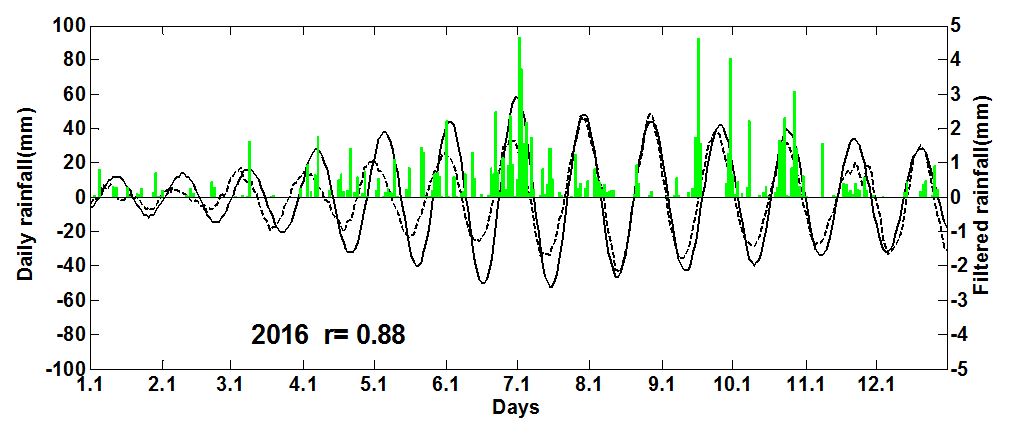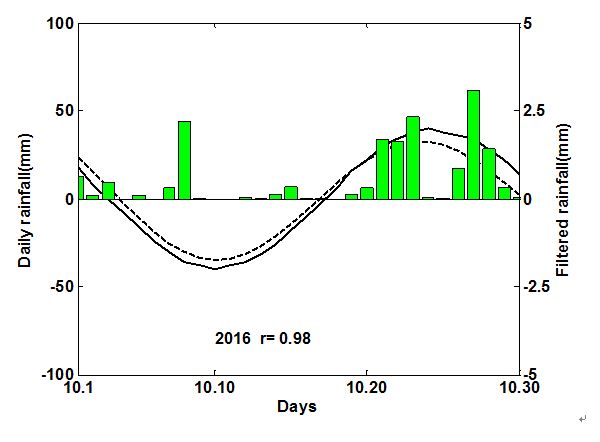

Source: Pubdate:2019-09-26 Hits:1690
The Application of Simple and High-order Extended Complex Autoregressive (ECAR) Model in the Low-Frequency Rainfall Forecast for the Extended Range
Yang Qiuming Jiangsu Meteorological Science Institute Research Group of Extended Range Weather Forecast
Abstract: the author has introduced the forecast methods of simple and high-order extended complex autoregressive (ECAR) model that is driven by data, and applied them into the real-time forecast of 20-30d low-frequency rainfall in the Lower Reaches of Yangtze River. The complex autoregressive model, which is based on the extended complex space of data transformation, identifies and describes the diversity of the main time-delay low-frequency correlations in mass of real and virtual data from more than one perspective. Meanwhile, the author also adopted the new real-time singular spectrum (SSA) filter wave to extract the real-time low-frequency signals in the observation data more accurately, which significantly improved the accuracy of real-time forecast of the Model. The author further forecasted the real-time extension of the 20-30d low-frequency rainfall in the Lower Reaches of the Yangtze River in the next 30 days, showing that the 25d forecasting skills from January to December reached 0.88. On the one hand, the significant positive phase changes of low-frequency rainfall during the continuous rainy season from late June to early July and late October 2016 were accurately forecast; on the other hand, the results provided the background information of great value for the forecast of continuous heavy rainfall in Meiyu Period and continuous rain in autumn.
Keywords: High-order Extended Complex Autoregressive (HECAR) Model; Extended Range Forecast; Heavy Rainfall in the Lower Reaches of the Yangtze River; Intraseasonal Oscillation (ISO)
At present, there are still more difficulties in the extended range weather forecast of 10-30d, which is mainly due to that the theoretical research is not complete. However, it has become one of the research hotspots attracting the concerns of the international community due to the urgent social needs of the 10-30d extended range forecast [1,2]. On the other hand, the global data generated from climate observations in the past 10 years has increased rapidly due to technical progress. These scientific big data with high data relevance and multiple data attributes can reflect and characterize complex natural phenomena and relations. We extracted some of atmospheric intraseasonal oscillation (ISO) change signals on the 10-90d time range closely related to extreme weather from mass of data by virtue of data decomposition, expansion and transformation techniques. A variety of innovative data products generated by new technologies are analyzed in respect of data. Next, dynamic data will drive complex low-frequency changes and system construction. As one of the effective ways to improve the forecast accuracy of the extended range forecast of low-frequency component, it is extremely important to prolong the forecast efficiency of extreme weather processes (such as continuous regional heavy rain, continuous high temperature, heavy temperature drop, etc.).
Recently, the author (2018) established a new high-order extended complex autoregressive model (HECAR) with original innovation for real-time forecast [3] based on the low-frequency component forecast model (LFCF) [2] proposed by the author (2014). This model, which is based on the low-frequency component of global circulation and rainfall, constituted an extended data matrix, and made the best of the Fourier transform to generate an extended complex sequence to form an extended complex matrix, as well as a simple high-order complex autoregressive model. In this sense, it is able to identify and describe the diversity of major time-delay low-frequency correlations and ISO-type variations in mass of real and virtual data in a multi-dimensional manner. Meanwhile, the newly developed data transformation-based sequential continuation scheme [real-time singular spectrum (SSA) filter wave method] has been employed in this data model, which can better suppress the boundary effect of sequential filter wave. In the forecast, this real-time SSA can not only obtain the ISO change signal more accurately, but also improve the stability of real-time forecast of the extended complex model and the forecast accuracy greatly and significantly.
The data-driven HECAR model [3] was applied to the real-time forecast of 20-30d low-frequency rainfall in the Lower Reaches of the Yangtze River from 2009 to 2014, showing that the forecast techniques can be stabilized for as many as 28 days (the fifth-order ECAR Model). It has more obvious advantages over the extended forecast model of the past 20 years at home and abroad and the latest extended forecast model in the past two years. By doing so, the real-time forecast time of heavy rain (heavy rainfall) in the Lower Reaches of the Yangtze River has been stably extended to 25-30 days. According to the further real-time extended forecast of the 20-30d low-frequency rainfall in the Lower Reaches of the Yangtze River in the next 30 days in 2016 (20-30d oscillation active year), it can be seen that the 25d forecast skills from January to December reached 0.88 (Figure 1). The significant positive phase changes of three rainy periods from May to July 2016 were accurately; among them, the positive phase changes of the continuous heavy rainfall during the Meiyu Period from late June to early July can be forecast about 25 days ahead of time. Furthermore, the positive phase corresponding to the three rainy periods in October-December can be well forecast; in particular, the forecast of the changes in the positive phase of low-frequency rainfall during the continuous rainy season in mid-to-late October is almost identical (Figure 2, and the correlation coefficient is 0.98). This shows that the continuous rainy process in the Lower Reaches of the Yangtze River in late October was successfully forecast about 20 days ahead of time. In consequence, HECAR can simulate the evolution of low-frequency signals of 20-30d in an accurate manner, thereby providing significant low-frequency background change information for the forecast of continuous heavy rainfall in Meiyu Period and continuous rain in autumn.

Figure 1. The 25d Forecast of the Fifth-order ECAR Model for 20-30d Low-frequency Rainfall in the Lower Reaches of the Yangtze River from January to December in 2016 (based on principal component of with global intensity of pressure of 850hPa of low-frequency meridional wind field), and the initial date is December 7, 2015, ... December 6, 2016. Among them, the solid (dotted) line represents the actual situation (forecast), and the column diagram represents the day-by-day rainfall change in the Lower Reaches of the Yangtze River in mm; r refers to the correlation coefficient between forecast and actual situation.

Figure 2: The 1-30d Forecast (dotted line) and Actual Situation (solid line) of 20-30d Low-frequency Rainfall in October 2016 in the Lower Reaches of the Yangtze River Valley, and the initial date is September 30, 2016; the column diagram shows the day-by-day rainfall change in the Lower Reaches of the Yangtze River in mm, r refers to the correlation coefficient between forecast and actual situation.
Both complexity and abundance of the natural world derive from the simplest images or elements; the harmonious beauty between simplicity and complex harmony is presented by science as a dialectics. It will not be advantageous to constructing a data model that describes low frequency variability by virtue of more complex deterministic model. In this sense, other factors such as simplicity, elegance in mathematical expressions may be more significant. Existing monitoring and forecasting thinking patterns and methods of weather and climate will be changed with the development of the age of big data. The colorful world of meteorological changes is full of numerous observational data. The focus of further research is on how to better integrate the power of data, and understand the weather and climate and forecast extreme weather and climate events in combination with the new data analysis techniques and knowledge of the Internet + era. Such technological innovations as science and technology development of data analysis and applications of new data products can be employed to extract more valuable information hidden in laws of data from observations and virtual data with a view to solving the problem of “massive data + simple logic” for complex phenomena, and reversing the simplified data model with greater predictability. Consequently, it is able to help the forecast model to fundamentally get rid of the constraints of predictability and realize the seamless forecasting of climate in short- and extending the forecast efficiency significantly.
(This article will be published on CHINA SCIENCE AND TECHNOLOGY ACHIEVEMENTS ( 2019))
References:
[1] Hoskins B. The potential for skill across the range of the seamless weather-climate prediction problem: a stimulus for our science. Quarterly Journal of the Royal Meteorological Society,2013,139:573-584.
[2] Yang Qiuming. Prospects and progresses in the research of the methods for 10-30 days extended-range weather forecast. Advances in Earth Science,2015,30(9): 970-984.
[3] Yang, Qiuming. Predictability and prediction of low frequency rainfall over the lower reaches of the Yangtze River valley on the time scale of 20―30 days. J Geophys Res,2018,123:211–233, doi:10.1002/2017JD027281.
(2019.9.26)